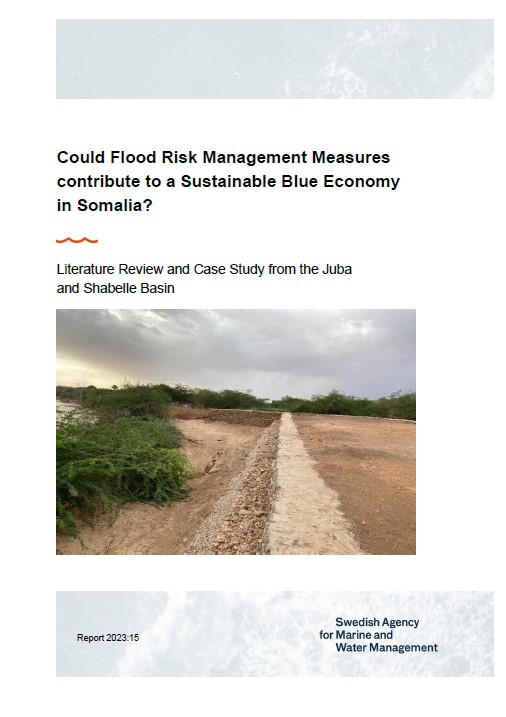Could Flood Risk Management Measures contribute to a Sustainable Blue Economy in Somalia?
Literature Review and Case Study from the Juba and Shabelle Basin.

Summary
Somalia experiences cyclic droughts every two to three years accompanied by devastating floods, particularly in the Southwestern regions. The floods occur when the Juba and Shabelle rivers burst their banks, affecting the livelihoods of about 1.8 million people. Flood control measures are therefore urgently needed, but their impacts on downstream communities and ecosystems have not been analyzed.
This study therefore aims to investigate how floods and different control measures in the Juba and Shabelle river basins, including mitigation and prevention measures affect the coastal environment and the development of a sustainable blue economy in Somalia.
A mixed-methods approach was used combining reviews of academic as well as grey literature on flood risk management and the Blue Economy of relevance to Somalia, with a questionnaire survey and interviews with local stakeholders in the central Juba-Shabelle River basin as well as key informants from international development partners. However, the literature and data from Somalia covering the targeted watersheds and rivers are limited, which has impacted the results and what is feasible to recommend.
Key Blue Economy sectors considered important include fisheries, livestock and agriculture, ports and shipping as well as energy and tourism. All sectors have been affected by floods and associated pollution, but especially small-scale fisheries.
This study has identified the following recommendations on actions to address challenges related to flood risk management and development of the Blue Economy in Somalia:
- The enabling environment needs to be strengthened to allow for multi-level policy implementation that links state-level and federal institutions and involve local communities and civil society.
- The destruction and decay of water infrastructure needs to be addressed as well as the very serious pollution related to solid waste, untreated sewage and chemicals from hospitals and farms from upstream sources of the Juba-Shabelle Rivers that also affects coastal areas and threatens small-scale fisheries.
- To strengthen the conditions for the Blue Economy, there are opportunities to implement more nature-based solutions and work with landscape features, such as forests, dunes and reefs.
- Planning and preparedness also need to be improved and a flood risk management strategy developed.
- Information, data sharing and monitoring should be strengthened and transboundary cooperation with Ethiopia pursued through for example transboundary water diplomacy and other security and reconciliation mechanisms.
- To save artisanal fisheries, the Juba and Shabelle Rivers need to be cleaned, and laws need to be enacted to reduce waste and pollution from upstream sources.
- The coastal area needs to be cleaned up and stabilized through use of landscape features and nature-based solutions, such as dune stabilization, planting of trees, mangroves and sea grass, and protection of natural habitats, such as wetlands, mangroves and coral reefs, building on analysis conducted by UNEP.
- Governance approaches that link upstream floods with downstream impacts are required, where multi-level and multi-scale governance arrangements can account for links across sectors and scales.
- Environmental flows should also be considered to ensure conservation of natural habitats important for regulation of water flows downstream and for conservation of biodiversity and provision of fish spawning grounds and nurseries, such as mangroves, coral reefs and sea grass beds.
- Trade-offs need to be considered between socio-economic benefits from development of the Blue Economy downstream with upstream flood risk management priorities and measures. Consideration must also be given to the effects of climate change and the ongoing drought.
In general, Somalia is at the early stages of readiness and awareness raising on source-to-sea linkages and the need for a holistic approach to development challenges.
However, as some progress has been made with coordination between sectors and development of a shared vision for FRM through the Hiiraan/Beledweyne Flood Committee and the federal Flood Risk Management Committee, the source-to-sea approach could be piloted in the Juba-Shabelle basin for priority flows of pollutants and waste that are threatening the development of the Blue Economy through capacity building of key stakeholders, action planning and development of monitoring and accountability mechanisms, building on ongoing support from UNDP, FAO and the World Bank.



